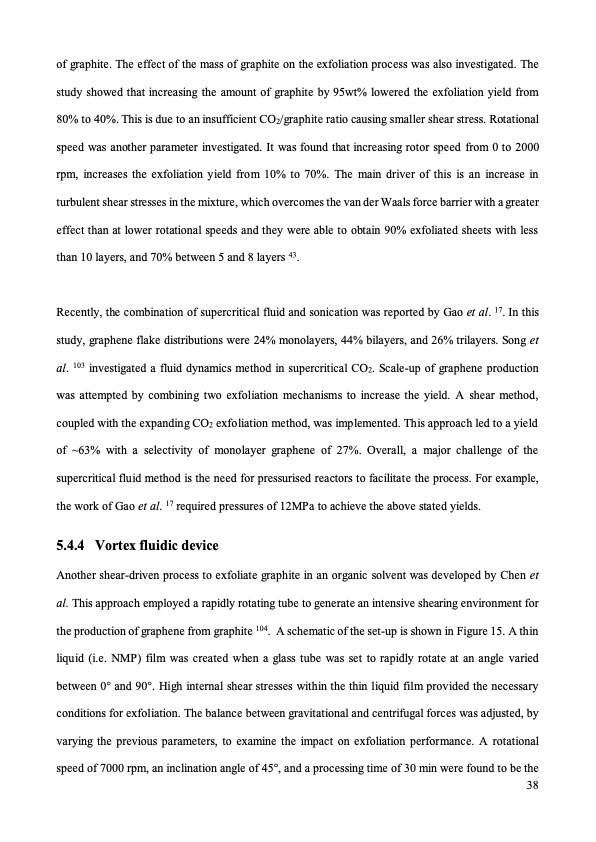
PDF Publication Title:
Text from PDF Page: 038
of graphite. The effect of the mass of graphite on the exfoliation process was also investigated. The study showed that increasing the amount of graphite by 95wt% lowered the exfoliation yield from 80% to 40%. This is due to an insufficient CO2/graphite ratio causing smaller shear stress. Rotational speed was another parameter investigated. It was found that increasing rotor speed from 0 to 2000 rpm, increases the exfoliation yield from 10% to 70%. The main driver of this is an increase in turbulent shear stresses in the mixture, which overcomes the van der Waals force barrier with a greater effect than at lower rotational speeds and they were able to obtain 90% exfoliated sheets with less than 10 layers, and 70% between 5 and 8 layers 43. Recently, the combination of supercritical fluid and sonication was reported by Gao et al. 17. In this study, graphene flake distributions were 24% monolayers, 44% bilayers, and 26% trilayers. Song et al. 103 investigated a fluid dynamics method in supercritical CO2. Scale-up of graphene production was attempted by combining two exfoliation mechanisms to increase the yield. A shear method, coupled with the expanding CO2 exfoliation method, was implemented. This approach led to a yield of ~63% with a selectivity of monolayer graphene of 27%. Overall, a major challenge of the supercritical fluid method is the need for pressurised reactors to facilitate the process. For example, the work of Gao et al. 17 required pressures of 12MPa to achieve the above stated yields. 5.4.4 Vortex fluidic device Another shear-driven process to exfoliate graphite in an organic solvent was developed by Chen et al. This approach employed a rapidly rotating tube to generate an intensive shearing environment for the production of graphene from graphite 104. A schematic of the set-up is shown in Figure 15. A thin liquid (i.e. NMP) film was created when a glass tube was set to rapidly rotate at an angle varied between 0° and 90°. High internal shear stresses within the thin liquid film provided the necessary conditions for exfoliation. The balance between gravitational and centrifugal forces was adjusted, by varying the previous parameters, to examine the impact on exfoliation performance. A rotational speed of 7000 rpm, an inclination angle of 45°, and a processing time of 30 min were found to be the 38PDF Image | graphene production via nonoxidizing liquid exfoliation

PDF Search Title:
graphene production via nonoxidizing liquid exfoliationOriginal File Name Searched:
Graphene-R2-review.pdfDIY PDF Search: Google It | Yahoo | Bing
Salgenx Redox Flow Battery Technology: Power up your energy storage game with Salgenx Salt Water Battery. With its advanced technology, the flow battery provides reliable, scalable, and sustainable energy storage for utility-scale projects. Upgrade to a Salgenx flow battery today and take control of your energy future.
| CONTACT TEL: 608-238-6001 Email: greg@infinityturbine.com | RSS | AMP |